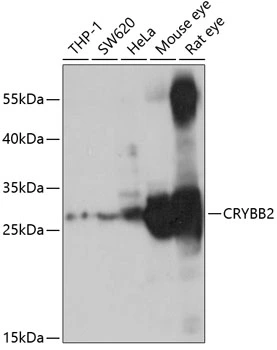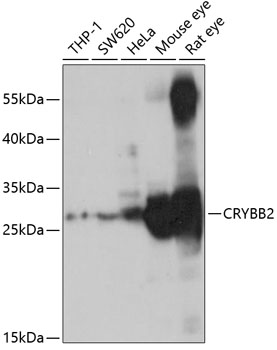
WB analysis of various sample lysates using GTX17574 beta B2 Crystallin antibody. Dilution : 1:1000 Loading : 25microg per lane
beta B2 Crystallin antibody
GTX17574
ApplicationsWestern Blot
Product group Antibodies
TargetCRYBB2
Overview
- SupplierGeneTex
- Product Namebeta B2 Crystallin antibody
- Delivery Days Customer9
- Application Supplier NoteWB: 1:500 - 1:2000. *Optimal dilutions/concentrations should be determined by the researcher.Not tested in other applications.
- ApplicationsWestern Blot
- CertificationResearch Use Only
- ClonalityPolyclonal
- ConjugateUnconjugated
- Gene ID1415
- Target nameCRYBB2
- Target descriptioncrystallin beta B2
- Target synonymsCCA2, CRYB2, CRYB2A, CTRCT3, D22S665, beta-crystallin B2, CTA-221G9.7, beta-B2 crystallin, beta-crystallin Bp, eye lens structural protein
- HostRabbit
- IsotypeIgG
- Protein IDP43320
- Protein NameBeta-crystallin B2
- Scientific DescriptionCrystallins are separated into two classes: taxon-specific, or enzyme, and ubiquitous. The latter class constitutes the major proteins of vertebrate eye lens and maintains the transparency and refractive index of the lens. Since lens central fiber cells lose their nuclei during development, these crystallins are made and then retained throughout life, making them extremely stable proteins. Mammalian lens crystallins are divided into alpha, beta, and gamma families; beta and gamma crystallins are also considered as a superfamily. Alpha and beta families are further divided into acidic and basic groups. Seven protein regions exist in crystallins: four homologous motifs, a connecting peptide, and N- and C-terminal extensions. Beta-crystallins, the most heterogeneous, differ by the presence of the C-terminal extension (present in the basic group, none in the acidic group). Beta-crystallins form aggregates of different sizes and are able to self-associate to form dimers or to form heterodimers with other beta-crystallins. This gene, a beta basic group member, is part of a gene cluster with beta-A4, beta-B1, and beta-B3. A chain-terminating mutation was found to cause type 2 cerulean cataracts. [provided by RefSeq, Jul 2008]
- Storage Instruction-20°C or -80°C,2°C to 8°C
- UNSPSC12352203




